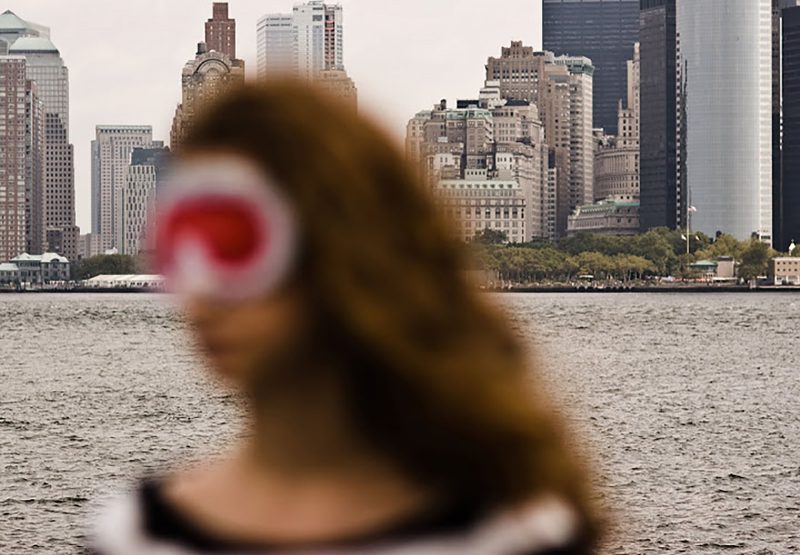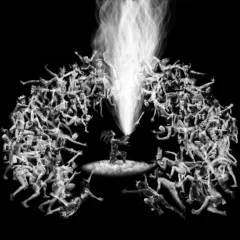Omnipresent in our everyday life, sound in all its distinctiveness is frequently obscured behind daily noises, i.e., loud sounds that compel and, for many, annoy. Since the early 20th century, artists have been enchanted by the compelling noises of the metropolis, and have explored the relational and synergetic effects of sound and art. In 1913, for example, the futurist painter Luigi Russolo, considered the first noise artist, created instruments called “noise intoners,” to capture sounds like the internal combustion engine, a scraper, a buzzer and a crackler, and he wrote music for these instruments. In the 1960s, Fluxus and other artists and musicians experimented with sound as a medium and a material in performances and Happenings. John Cage, composer and artist, famously created a piece, 4’33” in 1952, in which a performer sits at a piano and maintains silence for 4 minutes and 33 seconds.
Since then, visual artists, musicians, composers, and performance and media artists have continued to experiment with sonic practices, divorcing sounds and voices from their sources and activating real environments all the while blurring the boundaries with visual and performance art and music. They have also dismantled the strict lines between creators and listeners, and shaped Sound Art into today’s extremely heterogeneous art form. These explorations can be summed up in terms of “audio culture” and “aural culture.” The former questions sound as a material quality and generative process through analog instrumentation or digital technology, while the latter deals with our hearing ability and the interactive quality of sound.
Today in Philadelphia, more artists and musicians seem interested in exploring captured or specially-created sound and sharing that sound with listeners. And more curators seem interested in “exhibiting” sound pieces. Let us pin our ears to a small selection of performances and events in Philadelphia where practitioners are sharpening sound as an evocative ephemeral medium in the present moment.

Jane Carver, “The Chimera,” 2011.
Recording of Jane Carver (accordion and vocals) and Forest Christenson (violin) performed at Hunter College, in a room adjacent to the bus entrance of the Lincoln Tunnel, NYC. The song was first recorded and transcribed by the American ethnomusicologist Alan Lomax, capturing the song titled My Dear by Nazira Iusupova and the Uzbek Ensemble on the Moscow Radio in 1964.
Place and performance
The Philadelphia-based sound artist and performer Jane Carver is interested in reviving song archives through instrumental and vocal live performances. For her forthcoming contribution to Art in the Open, Carver will celebrate forgotten folk songs from around the world, while performing along the banks of the Schuylkill River. The songs she uses in her performance tell stories of arrival and departure, connection and separation, cities and mysterious seas. She memorizes the foreign songs in their original languages via a phonetic method and relies on her memory in performance, calling her songs “impossible.” Performing beside the river, her rendition of the Russian song “Kak Po Logu,” one of the songs she will sing, will mimic the fleeting ‘whooshes’ of the river’s waves. She will invite the passers by to contribute their own voices to the songs.
Carver’s re-enactment of historic songs will create a soundscape that will come and go like the river’s flow of water nearby. Catch a glimpse of her performance from May 13-15 at 5pm under the train tunnel just north of John F. Kennedy Blvd; performances will also be held earlier in the day in different locations in the Schuylkill Banks Park.
Nadia Botello, featuring Olivia Street Verdugo, “Duende,“ 2016. Recorded at the Icebox Project Space, Philadelphia.
Painting with sound
“I like that it sounds/feels like a siren calling a sailor to his death,” says Nadia Botello, indicating the compelling effects of her sound recordings at the Icebox Project Space. Activating the unique Kensington industrial warehouse annex with sound, Botello and other sound-artists-in-residence are filling the Icebox’s white cube with unusual sounds during the year of 2016. In contrast to Jane Carver’s analog performance, Botello and the others are “painting” multiple sound images in the Icebox using digital computer software and electronic voices. Echo, feedback, movement, and tonal reduction in the high-ceilinged cinder-block and concrete space make sound almost physical, palpable, synesthetic.
In their mostly non-public recording sessions–where recordings are made by the artists and the Icebox Project Space team–the artists experiment with the acoustics of the space and embrace the privacy of an empty gallery, a former walk-in freezer that originally processed frozen seafood. (Don’t miss the opportunity to experience the Icebox Project Space during one of the occasional public recordings on June 15 by Tatsuya Nakatani.) Co-director of the Icebox Ryan McCartney explains, “We are interested to understand what acoustics are capable of.” For McCartney, Sound Art is a practice that reflects upon sound’s intrinsically relational effects and capacity to transform space. Think how Niagara Falls without the sound would be transformed, for example.
The Icebox recordings are in the tradition of field recordings, such as the recorded American folk songs by Alan Lomax, who saved many songs and performers from being overlooked and forgotten, and by Max Neuhaus, one of the pioneers of sound installations in the 1970s. While the Icebox sound artists are not “in the field” in the same way as Lomax, artist-collaborators like Maria Dumlao and Eugene Lew have used the Icebox to test and record how their digital instruments create a polyphonic sound environment in a unique Philadelphia space–one that will soon be lost and forgotten as it is divided up and developed into smaller spaces. The Icebox recordings will be valuable reminders of the lost Icebox space.
Maria Dumlao and Eugene Lew, “Mimesis: Stage II”, 2016. Recorded at the Icebox Project Space, Philadelphia.
Through ephemeral sonic presentations, today’s artists are questioning not only what-we-hear and how-we-hear but also how we make sound available and what are the limits of sound archives and digitization.
The interviews were held with Jane Carver on April 18 in her studio and with Ryan McCartney on April 14 at the Icebox Project Space. The Icebox recordings are available free on SoundCloud and at the end of the year will be pressed into a vinyl LP.
Further reading:
Alan Licht, Sound Art. Beyond Music, Between Categories, Rizzoli: New York, 2007.
Barbara London, Anne Hilde Neset: Soundings: A Contemporary Score, MoMA: New York, 2013
Julia Gerlach: The Aesthetic Potential of Sound (information on the exhibition “Sound Art. Sound as a Medium of Art”), 2013.









